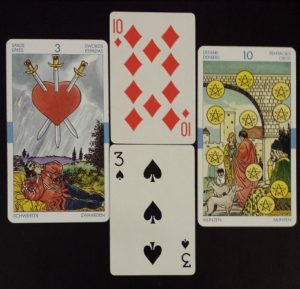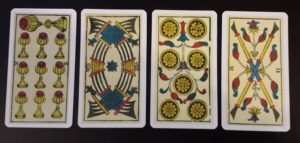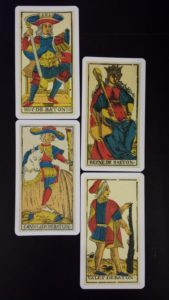Tarot cards are arguably the most popular divination tool in the Western World today. Yet despite the numerous tarot decks and instruction manuals available, there are still a number of questions surrounding them as such where did they come from? What came first: playing cards or tarot cards? Where does the word ‘tarot’ come from? This blog post aims to address all three of these questions, so read on to find the answers.

It has been speculated that tarot cards originated in Egypt, China, India and the Islamic World (Farley 2014; Levine 2004; Decker 2013). While some authors refer to some evidence to support their claims, others rely on speculation alone. For example, authors who think the tarot cards originated in India refer to the Indian game, Ganjifa, which has ten suits, each with twelve cards (Farley 2014). Others, like eighteenth century French Protestant Pastor Court de Gebelin, assumed that tarot cards came from Egypt simply because their images reminded him of Egypt (Levine 2004). While speculation alone isn’t a strong basis for an argument, there is some evidence to suggest that tarot cards where at least used in Egypt, even if they did not originate there.
A fifteenth century, fifty-six card deck from the Egyptian Mamluk Empire has been found in Istanbul and it features cards of four suits: coins, polo sticks, cups and swords (Farley 2014; Wintle 2015). Each of the suits has cards for the numbers 1-10, and four court cards: The King, Lieutenant, Second Lieutenant and Assistant (Wintle 2015). There are no Queens in this deck just as there are no Queens in any tarot decks that do not come from France or England (Farley 2014). Each of the cards also features an Arabic inscription, which are often whimsical, prophetic or unusual. Besides the obvious similarities between the suits of the Mamluk deck and conventional decks today, there are also similarities in the design of this deck and the Italian Brambilla and Visconti di Modrone tarot decks (Farley 2014).
The original concept of the Mamluk cards is thought to come from Persia where polo was invented and was the national sport of the nobility (Museum of Polo and Hall of Fame 2017). Furthermore, the Dabistan-ul-mazahab (The School of Manners) is a Persian language text which describes the exploits of Mahabad, the first human and prophet who organised society according to four classes: Magi (priests), Kings and warriors, farmers and artisans, and Sudin (workers). As such, the four suits of the Mamluk deck could represent the four classes of Persian society. As there is some consensus that tarot cards made their way to Europe via Italy (specifically through major port city of Venice) it is possible that the polo stick suit was changed to wands as polo was not a well-known sport in Italy at this time (Farley 2014).

Now that the origins of the tarot cards have been addressed, we can turn our attention to the name of these cards. Sadly, we do not know what the Mamluk deck was called. What we do know is that ‘tarot’ is the French word for these cards and that in other European countries, they are called taro, tarok or tarocco (Giles 1994). Some authors speculate that taro is an anagram of the Latin word rota, meaning wheel, and that this is a reference to the wheel of fate and how the tarot cards may be used to divine one’s fate (Decker 2013; Giles 1994). Others argue that Italian tarocco cards were originally called cartes de trionfi which translates as ‘cards with trumps’ and that this the origin of the word ‘tarot’. This ties in with the idea that tarot cards made their way into Europe via Italy and indeed, one of the earliest records we have of trump cards comes from Umbria, Italy.
From circa 1450AD, there is a record of a Franciscan Friar in Umbria giving a sermon on ‘the use of games’. In it, he divides all games into three classes: dice, cards and trumps. He goes on to describe trumps as having 21 cards which include a Pope, Emperor, angels and virtues (Giles 1994). At this time, the number zero was excluded from counting, so it is possible that there were actually 22 cards in a pack of trumps which would then correspond perfectly to the number of Major Arcana cards in a tarot deck.
From this, we can speculate that playing cards and trump cards were two separate things which became combined at some point in history. There is some evidence to support this given that a full Mamluk deck contains 56 cards, there are 22 trump cards in a modern tarot deck, and together this makes 78 cards which is exactly how many cards there are in a modern tarot deck. The fact that Mamluk cards and original tarot decks do not feature Queens in their court further supports this theory. As such, it would seem that modern tarot decks are a combination of Persian Mamluk playing cards and trump cards (most likely from Italy). Somewhere along the line, these two games were combined to make a tarot deck, and given the enigmatic inscriptions on the Mamluk cards, it is not difficult to imagine how playing cards became divination tools.

The fact that Mamluk playing cards can be traced back to ancient Persia also resolves the question of what came first: playing cards or tarot cards. In Europe, there are records of playing cards going back at least as early as 1371AD in Aragon (modern day Spain), while the earliest reference to trump cards come from 1442 in Ferrara, Italy. Given that Moorish occupation of Spain began in 711AD, and that the Arab conquest of Persia began in the seventh century, it is reasonable to assume that playing cards which originated in Persia came to Europe through Moorish occupation. Indeed, there is the theory that tarot cards originally made they via to Italy via Spain (Decker 2013).
The tarot deck now seems a little less shrouded in mystery. It is mostly a combination of two separate card games: one most likely from Persia and the other most likely from Italy. Through games of chance such as ‘pick a card’, it is easy to imagine how the inscriptions on the Mamluk cards became fortunes for the seeker. Over the years, the names, designs and interpretations of each card have been changed to suit their context in time and place. Today there are an abundance of tarot decks available to suit all tastes and tarot reading abilities, all of which add to the story of the cards.
References
Decker, R & Dummett, M 2013, A History of the Occult Tarot, Duckworth Overlook, London
Farley, H 2014, Cultural History of Tarot: Entertainment to Esotericism, I.B Tauris, London, viewed 21 September, ProQuest EBook Central
Giles, C 1994, The Tarot: History, Mystery and Lore, Simon and Schuster, Cammeray, NSW
Levine, N 2004, ‘The Diving Arts: Wisdom from the Land of Isis’, The Beltane Papers, vol. 33, pp. 42, viewed 21 September 2017, ProQuest,
Museum of Polo and Hall of Fame 2017, The origins of the sport, viewed 22 September 2017, < http://www.polomuseum.com/sport-polo/history-polo>
Wintle, A 2016, Mamluk playing cards, World of Playing Cards, viewed 23 September 2017, http://www.wopc.co.uk/egypt/mamluk
